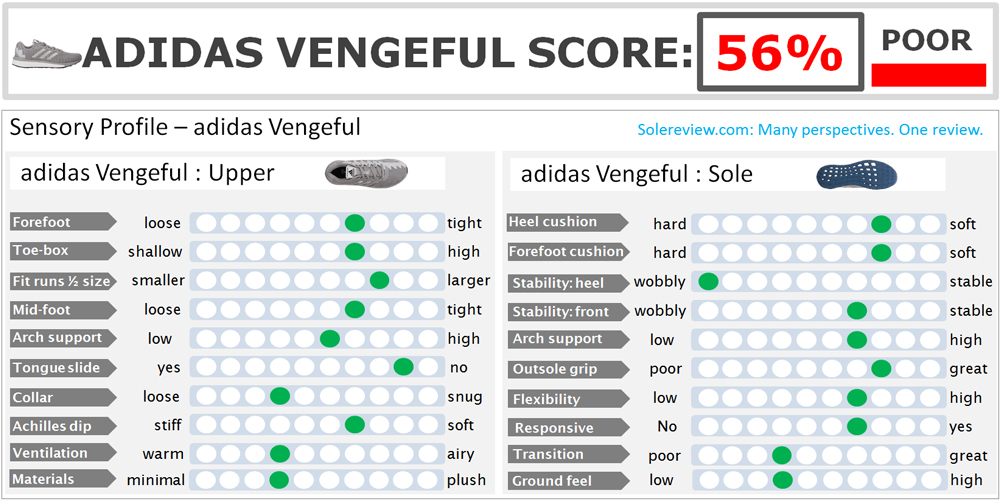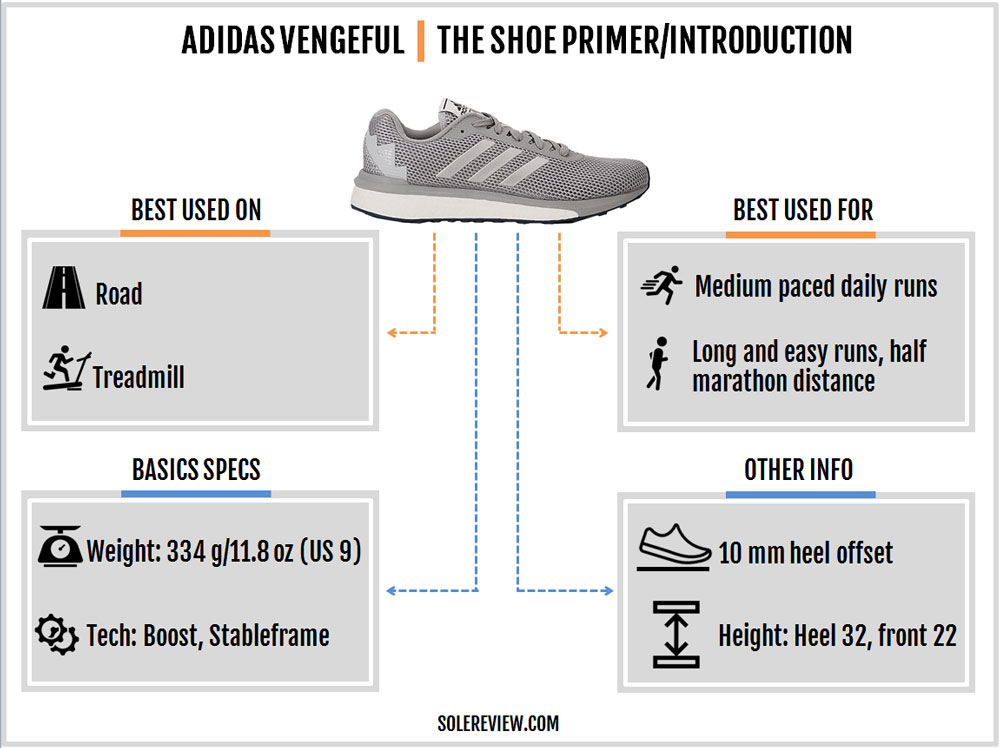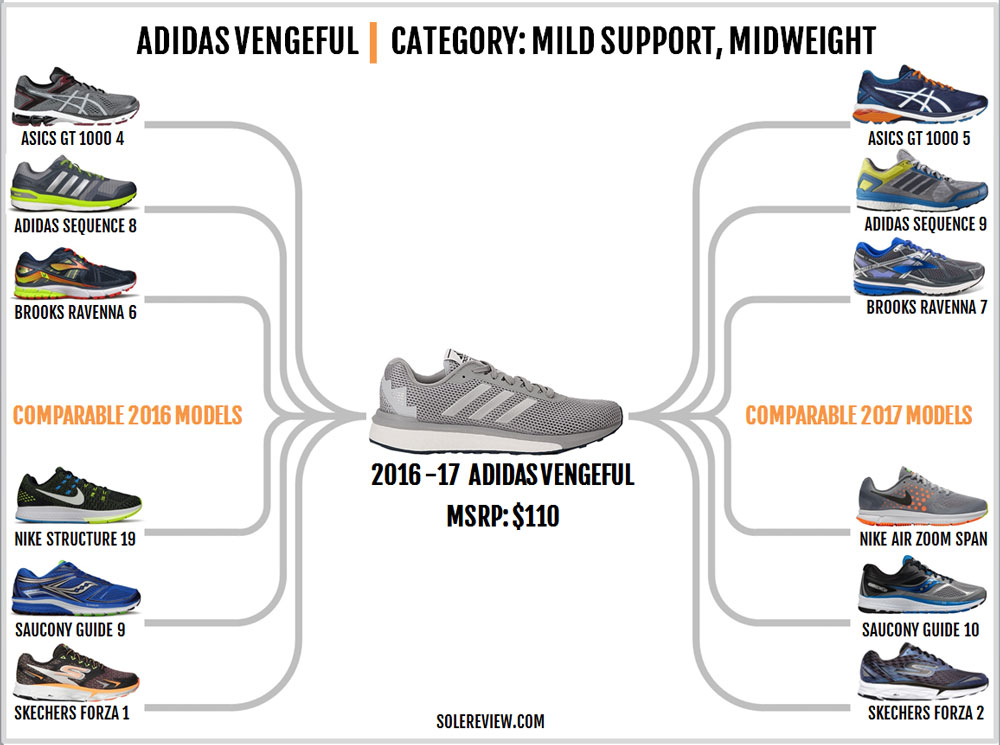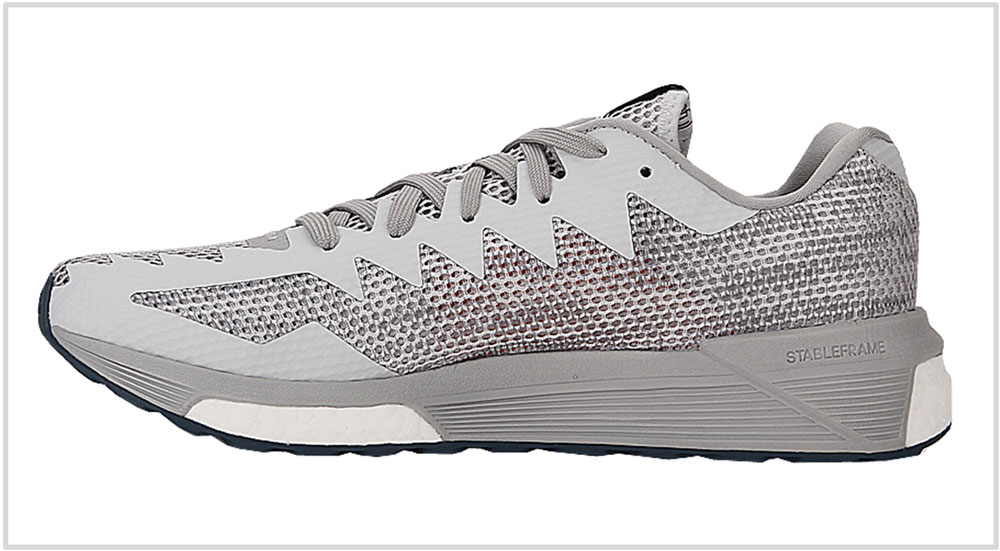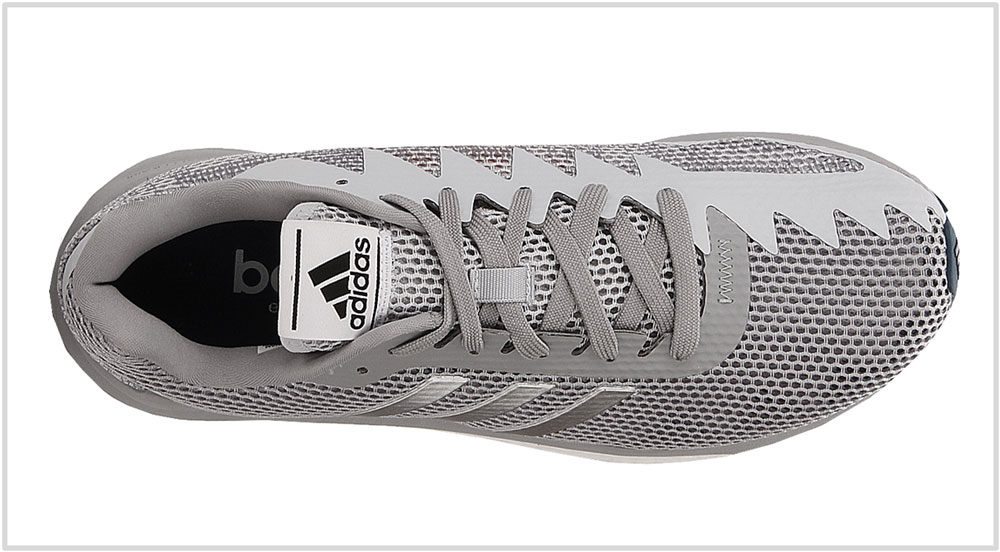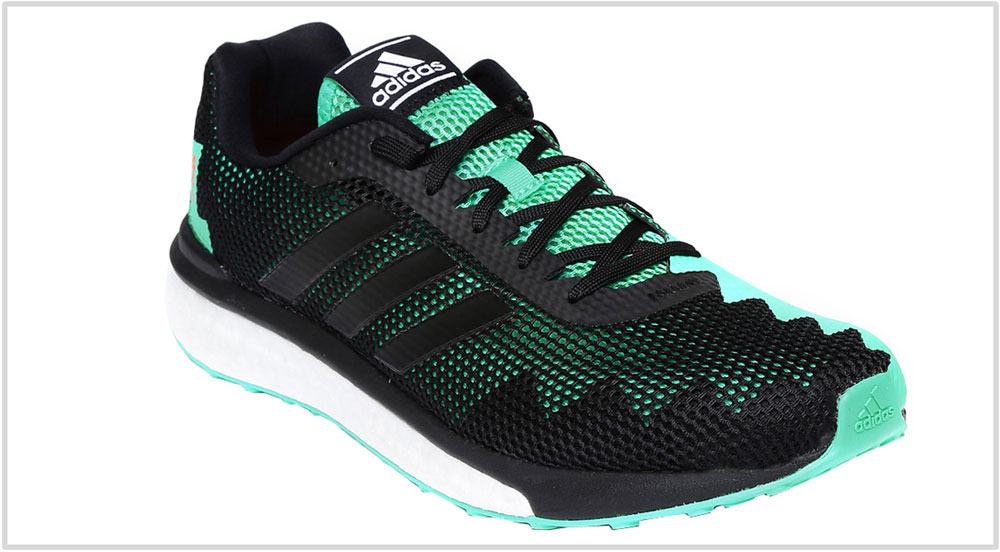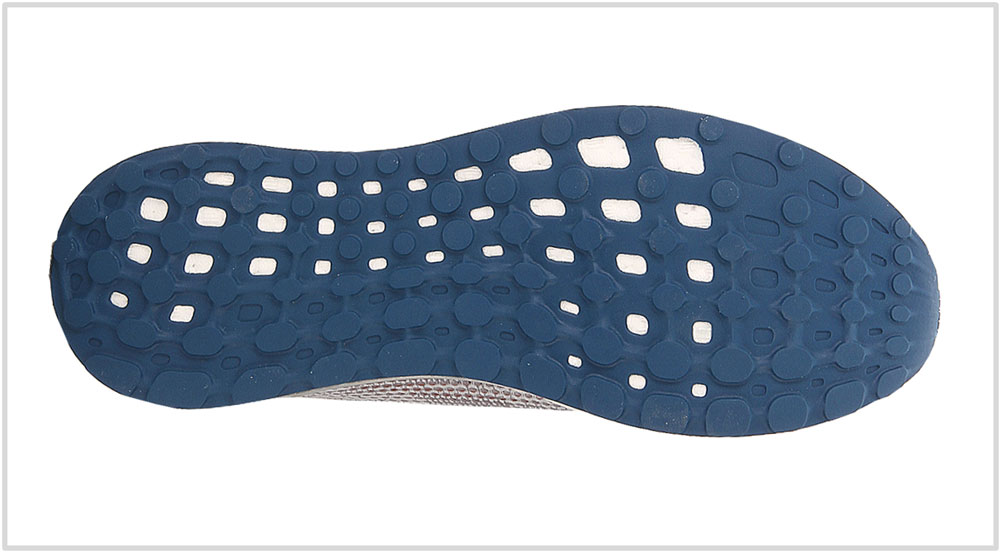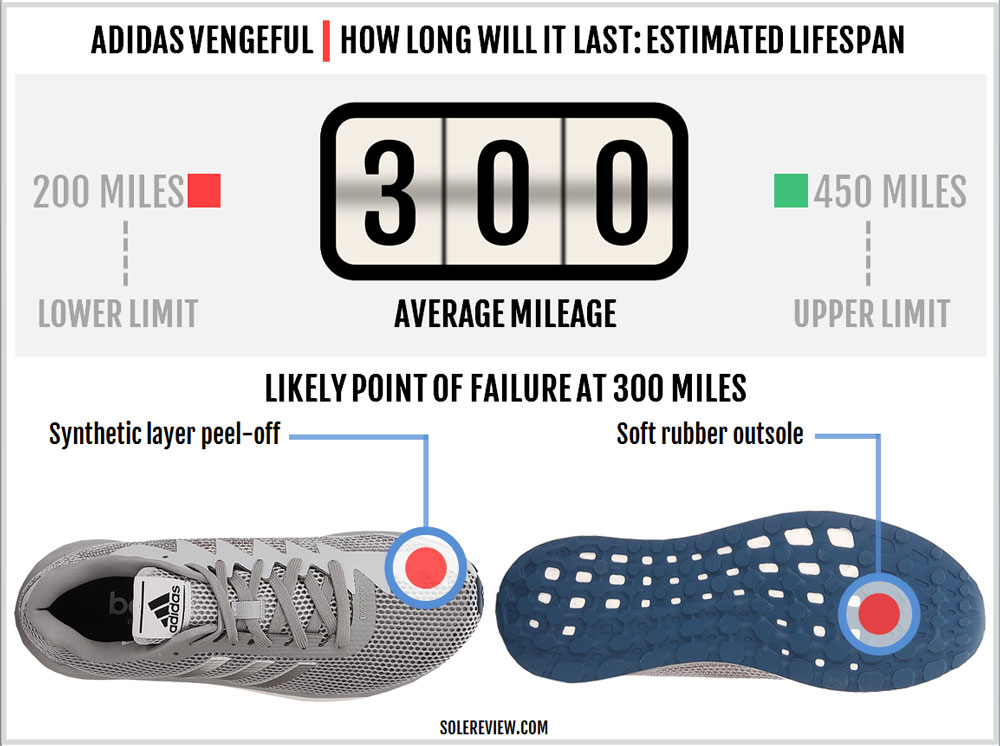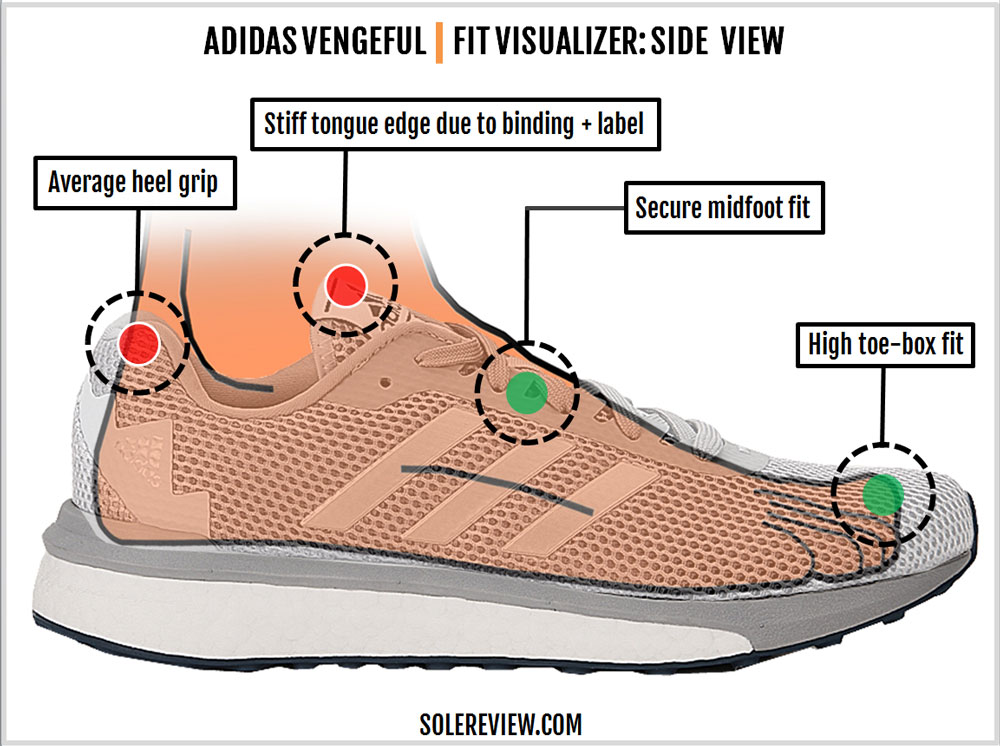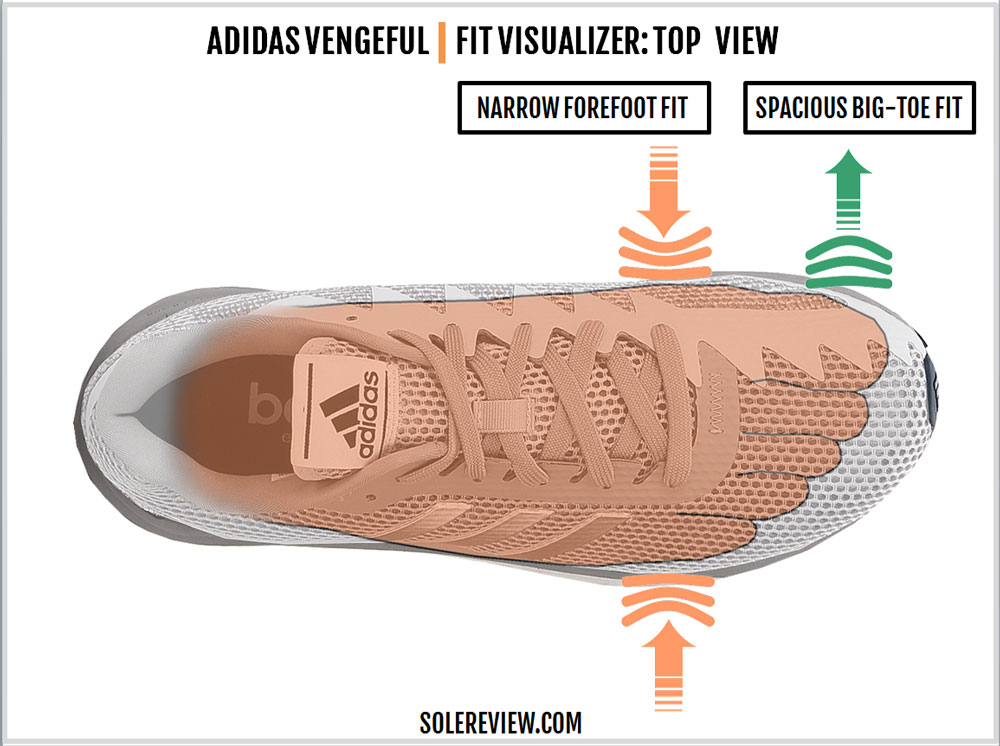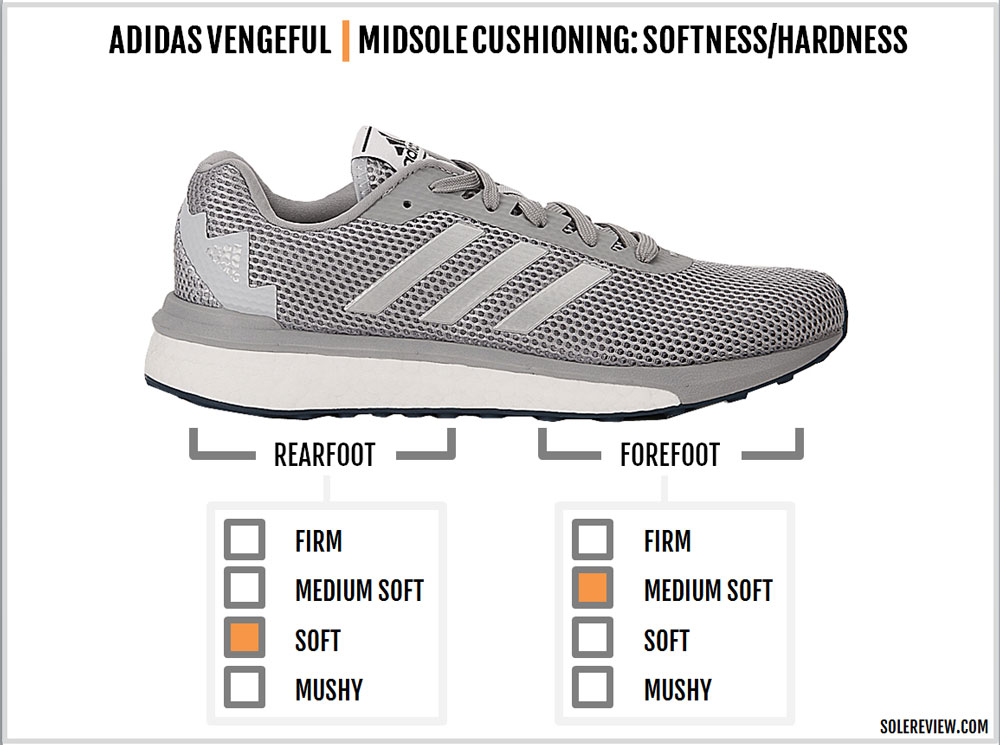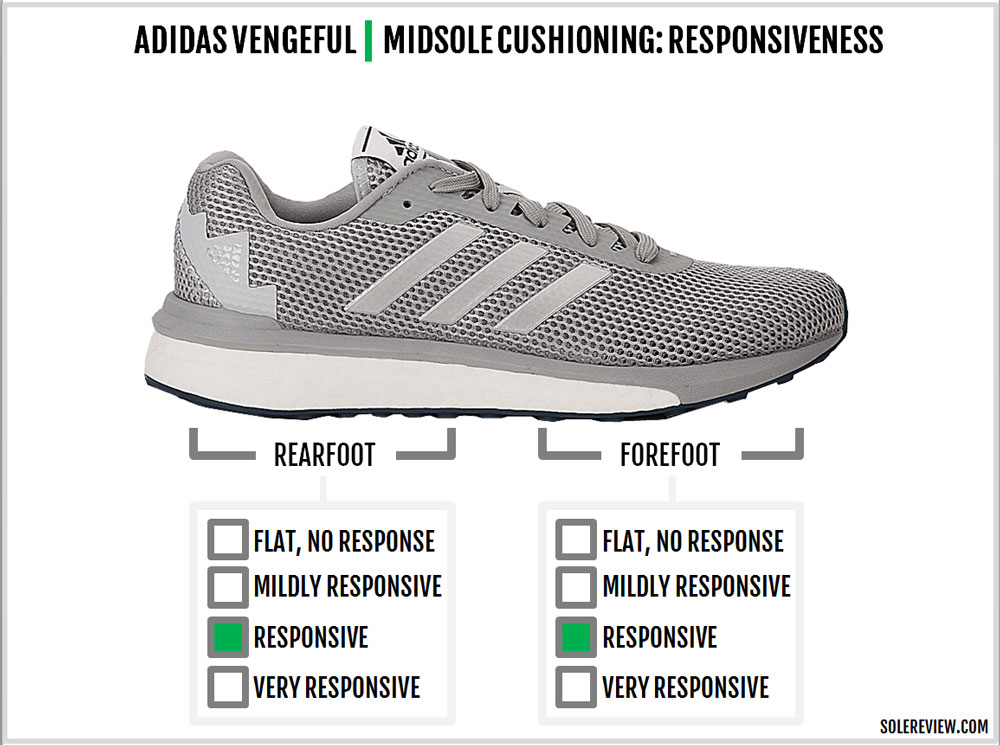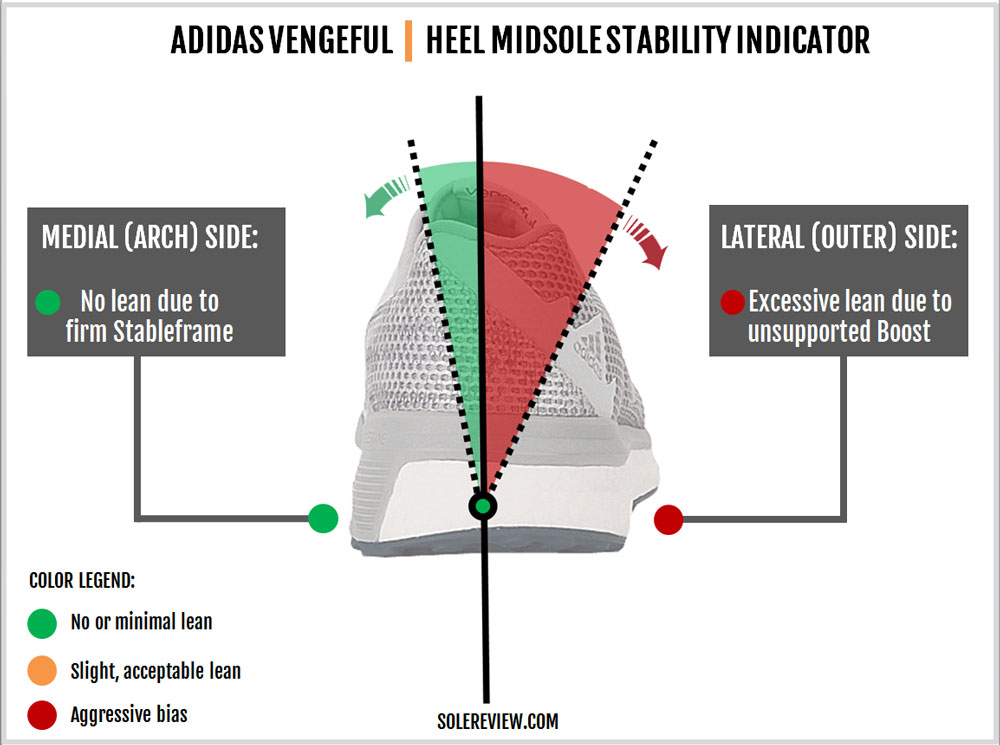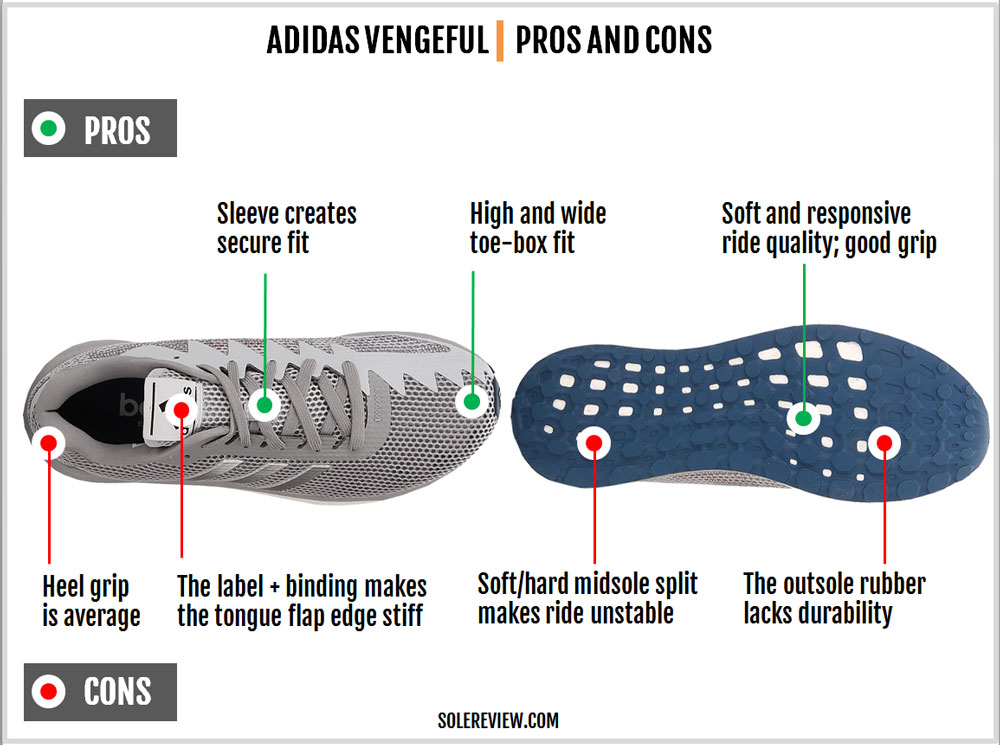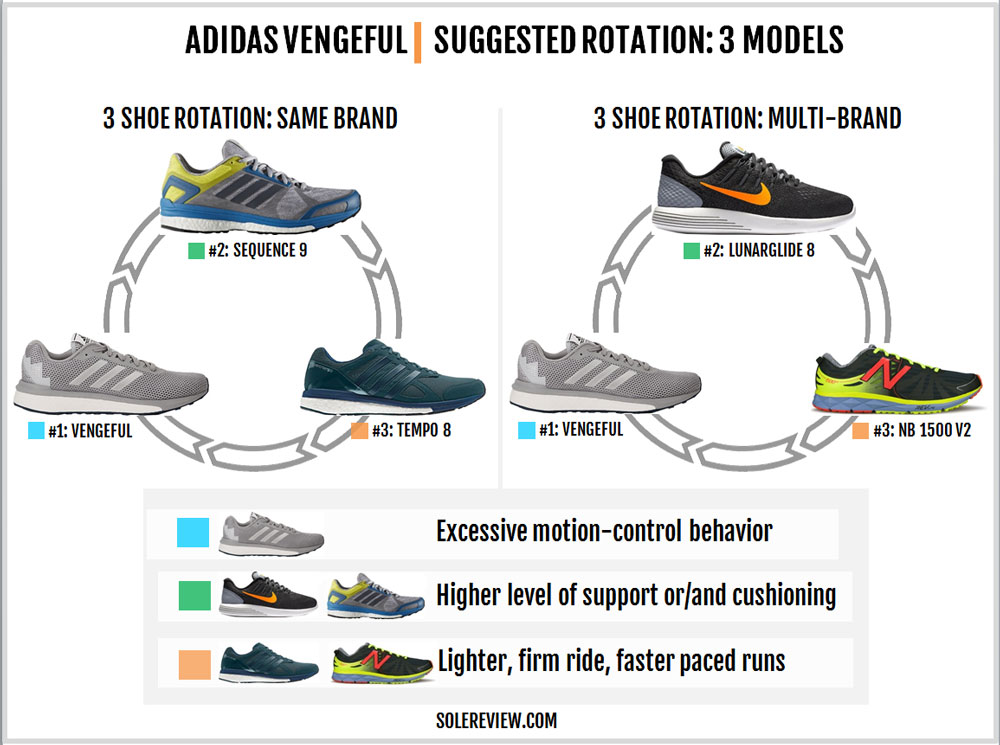INTRODUCTION
We did not see this one coming; the innocuous looking adidas Vengeful has turned out to be a bad running shoe.
It is incredible what just an extra helping of the EVA foam can do. On paper, the adidas Vengeful sounds like a reasonable product with well-meaning intentions. Its ‘Stableframe’ midsole establishes a support category connection with the $20 more expensive (and excellent) Supernova Sequence 9 Boost.
The Sequence 9 has a full-length Boost midsole with a firm EVA section on the medial side, a design which adidas calls ‘Stableframe.’ This is the German brand’s way of delivering midsole support, and it works like a charm on the Sequence 9.
The Vengeful’s part Boost, part EVA midsole goes by the same Stableframe name. So what does the Vengeful do differently (and poorly) than the Sequence?
If the Vengeful had stuck to the same midsole design as the Sequence, then there would be nothing to worry about. But the Vengeful showcases a modified Stableframe design which makes the ride shaky and unsupportive.
We’ll break down the inner workings of the Vengeful’s shortcomings at a later stage, but for now, Solereview’s recommendation is as follows:
If a supportive running shoe is what you’re after, then steering clear of the Vengeful is in your best interest. The $20 savings isn’t worth it.
Instead, get yourself the well-mannered Sequence 8 or 9. Besides, tis’ the Holiday season; you should be able to get your hands on a Sequence for a generous shave off its original retail price.
The Vengeful is a part of the mid-weight support category. The Vengeful’s $110 sticker price is lower than the rest, as the median MSRP for this assortment is $120. A few established names dominate this category; the Saucony Guide 10 has been around for a decade, and the Asics GT 2000 is an old workhorse too.
Also available at $120 are the Brooks Ravenna and the Skechers GoRun Forza, two shoes with distinct ride types. And as recommended, you should certainly consider the adidas Sequence 9 – which is basically a better version of the Vengeful.
There are only a couple of options at the $100 price point. The Asics GT-1000 5 is one, and the recently introduced Nike Air Zoom Span is another. Both are completely different shoes, but nonetheless options to consider.
All these support shoes come in various hues of ride and fit quality, but the Vengeful does one thing very differently than the rest. Ironically, that aspect of differentiation is also the reason behind the Vengeful’s abysmal score.
The Vengeful has an excess of motion-control behavior. The medial EVA Stableframe is much firmer than the Boost side, resulting in a ride quality which pulls the foot to the lateral (outer) side.
If you ask us, we’ll pick either the Nike Zoom Span or the Skechers GoRun Forza 2 instead. Both have a cushioned yet supportive ride, and are priced competitively.
What the heck, get anything but the adidas Vengeful Boost.
DESIGN AND MATERIALS
The Vengeful has an unconventional ‘two-face’ upper design. Look at the shoe from the lateral side, and the upper has a minimal, fuss-free design. The outer layer is made of a spacer mesh, with the tonal adidas Three-Stripes logo inconspicuously molded on the midfoot.
The lacing eyestay uses a fused urethane layer, as does the outer heel. The laces are a flat kind with a tiny amount of stretch, and there’s the additional heel-lock lacing available on standby.
On the medial side, the upper scenery transforms dramatically. Instead of the subtlety seen on the other side, the medial upper has a large piece of no-sew synthetic designed in a Zig-Zag fashion. The mesh underneath the synthetic is a spacer type, but separate from the lateral side.
The tongue is made of the same air-mesh as the medial upper, and underneath, there’s a soft tongue lining with a mild foam fill.
The tongue flap has a fabric binding and a woven label folded over. The flap flares out extremely wide at first, and then narrows down to join the inner sleeve.
The inner sleeve extends right up to the front. This means that while the Vengeful comes with a partially sleeved tongue, the rest of the midfoot and the forefoot has a bootie design. From the outside, the Vengeful appears well ventilated, but the dual-layered upper makes the insides warm.
If you examine the lateral upper closely, you’ll observe that the inner layer (under the spacer mesh) also has a jagged pattern. This inner pattern matches the outer layer on the medial forefoot and is visible only on Vengeful models with contrast colors – just like the one above.
The heel lining uses the same material as the tongue lining, and padding foam has been applied generously. However, unlike the Sequence 9, the Vengeful’s heel lacks a hard counter. There is no reflectivity either.
Paradoxically, the Vengeful is cheaper than the Sequence but has more midsole material. The Vengeful’s midsole has a higher volume of the Boost and EVA foam than the Sequence. This is apparent both by the visual appearance and the weight.
On the medial side, the Stableframe extends right up to the rearfoot, as opposed to the Sequence’s midfoot-only Stableframe. The height of the Boost foam section is taller than the Sequence. These differences manifest themselves in the shoe’s weight.
Even with the minimal upper design, the Vengeful Boost weighs 334 grams / 11.8 ounces, which is 8 grams or 0.3 ounces over the Sequence 9.
There are a few borrowed bits from the Sequence, like the removable EVA insole and the fabric lasting below it.
The Stableframe EVA is layered over the Boost foam, which means that the rearfoot does not have direct access to the soft compound. In the front, the rectangular cut-outs help the foot get in closer proximity to the Boost.
The Vengeful uses the ‘Sprintweb’ outsole design, a format which runs across the current adidas line-up. The Sequence, the Glide, and the Ultra, for example, use the Continental branded rubber in the same flat-lug layout.
Being a cheaper model, the Vengeful is left out of the Continental Club. It uses a soft rubber (vs. the hard Continental) material which is shared with the Response 3 Boost. It grips very well, though.
One of the things we noticed about the (first gen) Response Boost’s rubber was that it shredded quicker than either the adiwear or the Continental compound. A similar material is used on the Vengeful, so the outsole will have a shorter lifespan compared to its higher priced variants.
The upper is ok from a durability perspective except for the serrated layer over the spacer mesh. A part of it could potentially detach from the upper due to repeated flexing.
UPPER FIT AND FEEL
The internal bumper creates ample vertical room inside the toe-box. It also helps that the Vengeful fits slightly larger (see explanation after the next infographic), hence producing room in the front.
The midfoot sleeve uses a thin fabric which results in a smooth fit quality. The tongue, though sparsely padded, feels soft over the foot and filters the lacing pressure well.
Nonetheless, the raw tongue edge is stiff around the center flap. This is due to the woven label folded over the binding, which makes the edge even firmer.
We’re unable to fathom adidas’ motivations for designing the tongue this way. The similarly priced, and Vengeful’s neutral counterpart – the Response 3 Boost – uses a regular tongue flap with soft edges.
The heel grip is average. Though the lining is packed with foam, the unstructured heel doesn’t feel very secure without an internal (or external) counter.
The Vengeful has a long, but narrow upper fit. The heel does not have a hard stiffener inside, and this keeps the foot seated slightly towards the rear. As expected, this not only creates space ahead of the toes but on the sides as well.
In contrast to the toe-box, the forefoot fits narrow. The dual-layered mesh when combined with the inflexible synthetic on the medial side, restricts the amount of forefoot space available. In short, there is a lot of movement-restricting clutter over the forefoot.
The Vengeful’s optimal fit comes from being true to size. If you buy a half size larger, that will ease the forefoot fit but will leave excess space in the front.
RIDE QUALITY AND BEHAVIOR
Together, the Boost midsole and the insole make for a formidable cushioning stack. The molded EVA insole is thick, and the abundance of Boost below delivers softness. But there are a couple of caveats.
Firstly, the softness is biased towards the outer side of the midsole. That’s because the inner sidewalls are made of the firm Stableframe, while the soft Boost foam reigns supreme on the lateral side.
Secondly, the softness is concentrated in the lower area. The midsole has an EVA layer right under the foot, so the upper section has a firm feel. The lower midsole has the Boost and the soft Sprintweb outsole, both of which combine to produce a cushioned feel.
Boost foam is inherently responsive, so the Vengeful gets its fair share. But considering the thicker Boost midsole and the soft outsole, the sensation of laterally-skewed softness dominates the ride.
The forefoot feels more reactive to weight loading and roll-offs. The thinner stack allows for a greater compression of the Boost foam, and besides, the twin-windows cut into the lasting fabric makes the springy foam material more accessible.
We’ll not discuss the Vengeful’s transition or roll-off quality because all that is meaningless in the face of the shoe’s sub-par stability behavior.
The Vengeful differs from the well-behaved Sequence in two ways. There’s a higher stack of Boost foam, and a larger Stableframe on the inner side. The EVA piece makes the medial side extremely firm by covering the entire midfoot and rearfoot. On the lateral side, the Boost foam runs amok with softness.
The casualty of that skewed design is stability. The lateral side is very soft compared to the medial midsole, so the shoe constantly pulls to the lateral (outer) side. It’s the equivalent of running permanently on a cambered road, where your foot is permanently tilted at an unnatural angle.
This excessive rolling-out nature of the midsole might seem fine on paper as befits a ‘pronation control’ shoe. But the harsh reality is that the Vengeful completely lacks stability under the rearfoot. This is somewhat similar to the soft-heel, hard-heel Nike Structure 19, but only worse.
It doesn’t help that the upper lacks a heel counter, which only amplifies the unsupportive nature of the Vengeful.
PROS AND CONS
Not everything is rotten on the Vengeful; there are a few good things worth underscoring. The voluminous Boost midsole packs plenty of responsive cushioning power, and the soft rubber outsole grips well. For $110, the adidas Vengeful packs a lot of material value.
Some of the unimpressive bits would include the stiff tongue flap, the lack of reflectivity and ventilation, non-durable outsole, average heel grip, and a relatively high weight. And yet, none of these issues are deal-breakers.
The real problem is the Vengeful’s lack of stability, which ironically, is at odds with the Stableframe’s design objective. The midsole with a very soft lateral side and a very firm medial side leads to a precarious ride.
The gross mismatch of the foam densities is reason enough to give the Vengeful a wide berth.
RECOMMENDED ROTATION
You should avoid buying the Vengeful in the first place. But if you’re already committed, then do consider two other adidas shoes as a fail-safe.
The Sequence 9 is a no-brainer; its midsole bears the identical ‘Stableframe’ name, but the ride quality is far superior. Not only is the Sequence more supportive, but it will last longer too.
The Tempo 8 performs great as a lighter, yet supportive shoe. It also has the Stableframe midsole but is done right – like the Sequence.
Alternatively, the New Balance 1500 V2 is another excellent speed shoe with a similar support character. Like the adizero Tempo, the 1500’s support feature – the medial post – is a non-intrusive kind
If for some reason, you’re not smitten by the idea of getting a Sequence Boost, then the Lunarglide 8 is a dependable fallback. It has a cushioned ride, courtesy the Lunarlon core, and the firm midsole casing makes the ride supportive.

